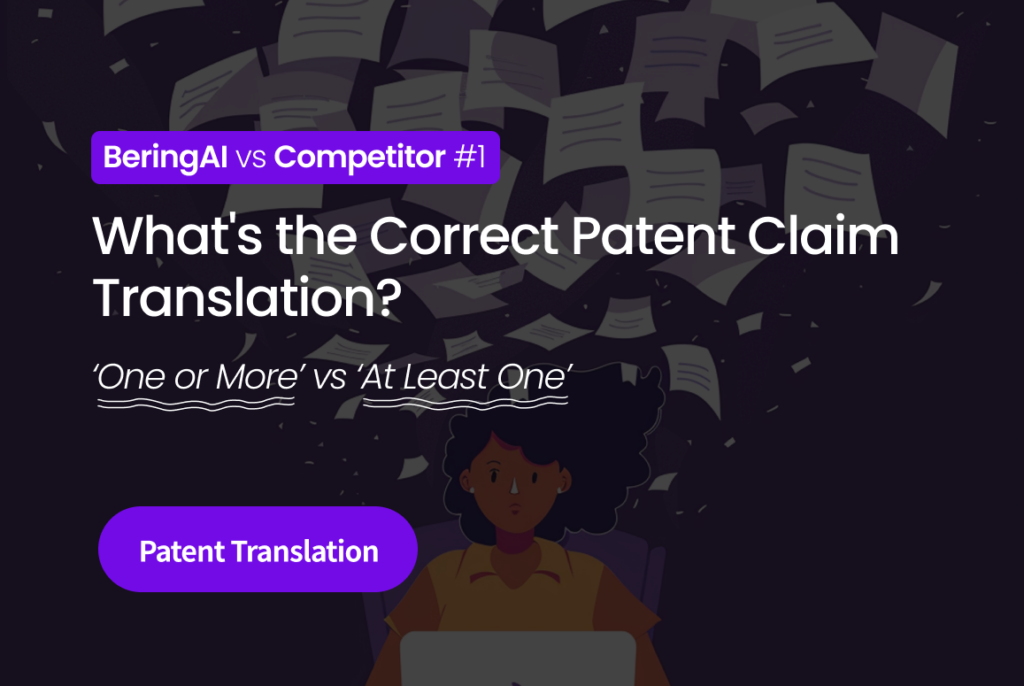[BeringAI] “One or More” vs. [Competitor] “At Least One” – What’s the Correct Patent Claim Translation?
Today, we introduce content that offers tips on navigating the complexities of patent translation by comparing the accurate translations of BeringAI with the incorrect examples from a competitor. We will continue to provide a series of insights into BeringAI’s patent translation results, so stay tuned!
Let’s dive into the translation of patent claims, which can be considered the heart of patent translation. Claims are the most critical part of a patent document. Simply put, they are sentences that accurately describe the key aspects of the technology you wish to protect with a patent. Thus, they serve as a protective belt for your invention.
Claim translation is both important and challenging. It requires the selection of precise terminology suited to the technical field, as well as consideration of the examination regulations of the filing country. A single word or sentence can determine the fate of a patent. Today, we will explore good and bad examples of claim translations to identify which translations are correct and which should be avoided.
By examining both good and bad examples side by side, you will better understand the key points of claim translation. You will be able to clearly compare which expressions broaden a patent’s scope of protection and which narrow it.
✍️ BeringAI Translation vs. Competitor D’s Translation
[Original] 제1항에 있어서, 상기 5 또는 6개의 탄소 원자를 갖는 1,2-디알콕시알칸 및 5 또는 6개의 탄소 원자를 갖는 1,3-디알콕시알칸으로 구성된 군 중 하나 이상은 1-에톡시-2-메톡시에탄, 1-메톡시-2-프로폭시에탄, 1,2-디메톡시프로판, 1-에톡시-2-메톡시프로판, 2-에톡시-1-메톡시프로판 및 1,3-디메톡시프로판으로 구성된 군 중 하나 이상으로부터 선택되는, 전기화학 전지.
[BeringAI] The electrochemical cell of claim 1, wherein one or more of the group consisting of 1,2-dialkoxyalkanes having 5 or 6 carbon atoms and 1,3-dialkoxyalkanes having 5 or 6 carbon atoms are selected from one or more of 1-ethoxy-2-methoxyethane, 1-methoxy-2-propoxyethane, 1,2-dimethoxypropane, 1-ethoxy-1-methoxypropane and 1,3-dimethoxypropene.
[DeepL] The claim of claim 1, wherein at least one of the group consisting of 1,2-dialkoxyalkanes having 5 or 6 carbon atoms and 1,3-dialkoxyalkanes having 5 or 6 carbon atoms is 1-ethoxy-2-methoxyethane, 1-methoxy-2-propoxyethane, 1,2-dimethoxypropane, 1-ethoxy-2-methoxypropane, 2-ethoxy-1- methoxypropane, and 1,3-dimethoxypropane, wherein at least one of the groups consisting of
1️⃣ “In ~”: Accurate Dependent Claim Translation

Claims are broadly divided into independent and dependent claims. While independent claims cover the core content of the invention, dependent claims further define or add additional features to the independent claims. The key to translating dependent claims is ‘accurate citation.’ In simpler terms, you need to correctly refer to the previously stated claim while adding new content. Here are some important points to consider:
First, citation expressions like “In ~” must match the original text. Second, you need to accurately identify the main subject mentioned at the end of the sentence, such as “electrochemical cell.” BeringAI’s translation correctly references “electrochemical cell” while citing claim 1, whereas Competitor D’s translation makes a critical error.
Dependent claims must include all the features of the previous claim while describing additional features. However, “The claim of claim 1” fails to reflect such dependency. This kind of mistranslation can significantly narrow the patent’s scope of protection. A small mistake in translating dependent claims can have a major impact on the entire patent. Therefore, it’s crucial to accurately understand the structure of the original text and not overlook key terms.
2️⃣ “하나 이상”: What’s Appropriate?

The expression “하나 이상” might seem straightforward, but it poses a considerable challenge during translation. It is generally translated as “one or more” or “at least one.” Why does BeringAI translate it as “one or more”?
Translating it as “one or more” allows for a natural expression like “the one or more” when referring to the configuration later. This is also a more standard expression in English grammar. On the other hand, using “at least one” may lead to slight awkwardness. While “the at least one” is grammatically correct, it’s less common in patent documents.
Of course, this translation isn’t an absolute answer. Preferences for expressions can vary depending on clients and filing countries. However, BeringAI’s translation reflects these differences, resulting in more accurate and natural expressions.
Commonly Used Expressions:
- One or more 하나 이상
- At least one 적어도 하나
- More than, above 초과
- Equal to or more than 이상
- Less than, below 미만
- Equal to or less than 이하
3️⃣ Is? Are?: Subject-Verb Agreement in English
Subject-verb agreement can be challenging due to differences between Korean and English. While Korean verbs don’t distinguish between singular and plural, English does. Therefore, special attention is needed when translating expressions like “one or more.”
👍 BeringAI’s translation uses “one or more” with the plural verb “are.” Why is this? “One or more” implies more than one, so it must be treated as plural. Therefore, using “are” is grammatically correct.
🚨 DeepL’s translation uses “at least one” with the singular verb “is.” At first glance, it seems correct, but this can lead to problems. “At least one” also means ‘one or more,’ so it should be treated as plural.
Why are such minor errors dangerous? Grammatical errors in patent documents can lead to ambiguity in interpretation. In the worst-case scenario, the patent’s scope of protection could be limited, or the patent itself could be invalidated. Therefore, relying solely on commercial machine translation tools makes it challenging to achieve accurate translations.
That’s why Bering Lab developed BeringAI, an AI translation service specialized in legal and patent translations. As seen in the examples above, BeringAI accurately translates subtle expressions like “one or more.” In contrast, general translation tools or those from other companies may make errors in these intricate aspects.
BeringAI has a customized engine specialized in legal translations, which helps prevent such errors. BeringAI precisely understands the characteristics of patent documents and provides results that closely resemble the original document. It even replicates the document’s formatting, significantly reducing the time and effort required for post-editing. With BeringAI, you can translate complex legal terms and expressions accurately and efficiently.
Currently, over 130 law firms and global companies worldwide are using our services. Trusted by top law firms domestically and internationally, Bering Lab! Bering Lab also offers ‘patent translation’ three times faster and 40% cheaper through BeringAI and BeringAI+ services. Elevate the quality of patent translations with BeringAI to ensure your client’s intellectual property is properly protected!
🚀 Start your legal translation quickly and easily with BeringAI.
🔍 Use BeringAI+ for reliable translations reviewed by experts!

